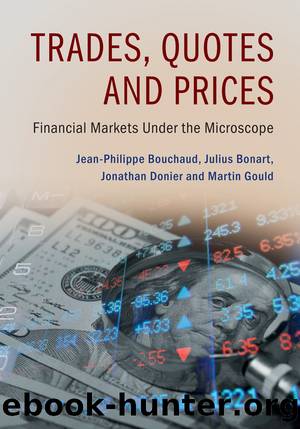Trades, Quotes and Prices: Financial Markets Under the Microscope by Jean-Philippe Bouchaud Julius Bonart Jonathan Donier and Martin Gould

Author:Jean-Philippe Bouchaud, Julius Bonart, Jonathan Donier and Martin Gould
Language: eng
Format: epub
Publisher: Cambridge University Press
11.5 Conclusion
The primary conclusion of this chapter is that there exists a clear empirical correlation between the signs of trades and the directions of price moves. Trivial as it may sound, the mechanism underlying this behaviour is not immediately clear. Does this phenomenon occur because information is revealed? Or does the very occurrence of a trade itself impact prices? Generally speaking, one expects that both effects should contribute. However, empirical data suggests that the reaction part of impact is predominant on short to medium time scales, and is identical for all trades irrespective of whether they are informed or not. Since trades in modern financial markets are anonymous, it would be surprising if any distinction (between whether or not a given trade was informed) could be made before any genuine prediction contained in some of these trades reveals itself. By a similar argument, one expects that the impact of trades could also explain a large fraction of the volatility observable in real markets (see the discussion in Chapter 20).
From the point of view of this book, this is very good news! It suggests that there is hope for modelling the reaction part of the impact, which should follow reasonably simple principles, as we shall discuss in Chapters 13 and 19. The prediction part of impact is of course much harder to model, since it depends on a huge information set and on the specific strategies used to exploit mispricings. In any case, the information content of individual trades must be very small (see Chapters 13, 16 and 20). Furthermore, as we will see, the decay of the reaction impact is so slow that the distinction between transient impact (often associated with noise trades) and permanent impact (often associated with informed trades) is fuzzy.
Several empirical conclusions from this chapter will now trickle throughout much of the rest of the book. For example, we saw in Section 11.3.1 that the lag-1 impact of a market order is of the same order as the bid–ask spread. We will investigate this from a theoretical perspective in Chapter 17. We also saw in Section 11.3.1 that the response function is an increasing function of ℓ that saturates at large lags (see Figure 13.1). This can be traced back to the autocorrelation of the trade-sign series (see Sections 13.2 and 16.2.4, and Equation (16.22)), from which we will construct a theory for the reaction impact of trades (see Chapter 13). In Section 11.3.4, we saw that the impact of two trades in the same direction is less than twice the unconditional impact of a single trade. This is due to liquidity providers buffering the impact of successive trades in the same direction, and is a crucial condition for market stability, as we will see in Sections 13.3 and 14.4.
Finally, we have discussed the impact of trades at an aggregate level. We saw that small price returns are linearly related to small volume imbalances, with a slope (called “Kyle’s lambda”) that is found to decrease with the aggregation time scale T.
Download
This site does not store any files on its server. We only index and link to content provided by other sites. Please contact the content providers to delete copyright contents if any and email us, we'll remove relevant links or contents immediately.
The Complete Stick Figure Physics Tutorials by Allen Sarah(7135)
Secrets of Antigravity Propulsion: Tesla, UFOs, and Classified Aerospace Technology by Ph.D. Paul A. Laviolette(4974)
Thing Explainer by Randall Munroe(3782)
The River of Consciousness by Oliver Sacks(3412)
The Order of Time by Carlo Rovelli(3072)
How To by Randall Munroe(2911)
I Live in the Future & Here's How It Works by Nick Bilton(2839)
A Brief History of Time by Stephen Hawking(2819)
What If?: Serious Scientific Answers to Absurd Hypothetical Questions by Randall Munroe(2542)
The Great Unknown by Marcus du Sautoy(2532)
Midnight in Chernobyl by Adam Higginbotham(2385)
Blockchain: Ultimate Step By Step Guide To Understanding Blockchain Technology, Bitcoin Creation, and the future of Money (Novice to Expert) by Keizer Söze(2379)
Networks: An Introduction by Newman Mark(2264)
The Meaning of it All by Richard Feynman(2213)
Easy Electronics by Charles Platt(2204)
The Tao of Physics by Fritjof Capra(2162)
Midnight in Chernobyl: The Untold Story of the World's Greatest Nuclear Disaster by Adam Higginbotham(2074)
When by Daniel H Pink(2020)
Introducing Relativity by Bruce Bassett(2016)
